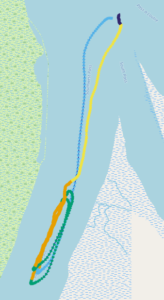C-Job R&D: Operational Profile Analysis
The momentum driving C-Job’s Research and Development forward is striking. For many companies, 2020 has been a year defined by an overwhelming sense of uncertainty, seeing many projects being put on the back burner. Not so, C-Job’s R&D team. Working primarily from home and not letting their work be held back by coronavirus restrictions, they have been working on a new branch of research: Operational Profile Analysis.

“One of the principal aims of this research is to challenge the assumptions that are often made at the beginning of the design process,” opens Roy de Winter, Data Scientist at C-Job Naval Architects. “This is the most important phase of the whole design process. This is when all the critical decisions are made and when most of the budget is allocated.”
Indeed, the choices made in the early design stages relate to issues of immense significance. How big is the vessel going to be? What type of engine will it have? Who will supply the mission equipment?
“You need to decide all these things upfront. Therefore, it shouldn’t be based on a gut feeling. Operational profile analysis provides a means to validate the assumptions made at the beginning of the design process.”
Data, data and more data
The research is based on analysis of data, the results of which can optimize new ship designs as well as improve operations of existing vessels and fleets. “We analyze a lot of data,” says Roy de Winter. “For example, about weather, currents, wave height, cloud cover. Satellite data too. A client can also provide us with the data from their on-board sensors. A ship could generate a lot of data, in one case we encountered more than 250 on-board sensors, generating hundreds of gigabytes of data per year. This equates to an excel spreadsheet with 28,000 rows of data for each day.”
At this point, it should come of no surprise to read that, unlike most of his naval architect or maritime engineering colleagues, Roy is actually a computer scientist. Dealing with such huge datasets is his arena of expertise. He can extract the data most relevant to a client’s specific needs.
Computer science meets naval architecture
When faced with such an array of data, how does Roy know which to use and which to disregard? “This is where the naval architects come in,” he smiles. “They know what they need to analyze. Maybe it’s fuel consumption, or maybe about stability. Or about average speed over the last year.”
The resulting information from the operational profile analysis is available to the client via C-Job’s user-friendly tool. This allows them to view the analysis with just a click of a button and get insights from the naval architect on the project.
As such, operational profile analysis can be described best as a synergy of computer science and naval architecture. Its results can be implemented through the maritime industry, offering benefits to owners of a multitude of ship types.

Analyzing sensor data
Real world examples
Example 1:
A dredging company is looking to build a new vessel. By analyzing the operational profile of the company’s current fleet, the actual time spent on different activities is determined. This shows the exact times spent actively dredging, sailing empty, sailing full, dumping, or maneuvering. No assumptions are made; decisions are based on data.

Pictured: Dredging cycles detection; sailing empty,
dredging, maneuvering, dredging, and finally sailing full
Example 2:
A ship-owner wants to reduce the fuel consumption of a vessel. This could be any type of vessel: a ferry on a predictable round-trip route, an ocean-going cargo carrier, or a fishing trawler, for instance. C-Job can use operational profile analysis to determine if the vessel’s design speed and operational speed are mismatched. If this is the case, a variety of options can be investigated to remedy the situation.
Perform a Computational Fluid Dynamics study (to see if hull modifications would improve sailing efficiency)
Install a more energy efficient engine (to ensure delivery of enough energy to sail at the design speed)
Install a new propeller (one that actually matches the design speed)
Identify the most energy efficient speed (maybe this means slow sailing)